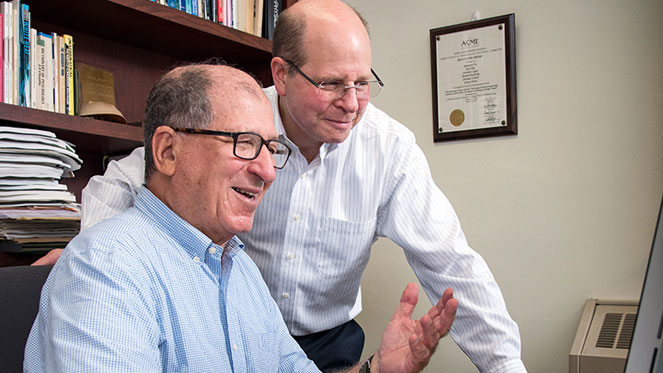Design Cognition’s Dynamic Duo
CMU’s Ken Kotovsky and Jon Cagan Reflect on Two Decades of Collaboration
By Emily Stimmel

Brainstorming ways to improve access for individuals with disabilities. Designing peanut-shelling devices for use in villages without electrical power. Building bridge trusses under challenging—and changing—conditions. These are just a few applications of design cognition, which taps into the thinking processes of designers as they approach difficult problems.
The field has been pioneered by two people: Carnegie Mellon University’s Ken Kotovsky and Jon Cagan. Through their 24-year partnership, they have worked at the intersection of psychology and mechanical engineering, using their understanding of the cognitive processes involved in human problem solving to improve engineering design.
The two connected through their mutual admiration of the late Nobel and Turing Award laureate and CMU Professor Herbert A. Simon, who advised Kotovsky on his Ph.D. and inspired Cagan to view design as a problem solving technique. In fact, Simon is credited with introducing the notion of “design thinking” in his 1969 book, “The Sciences of the Artificial.”
“We initially thought it would be fun to do something together as friends, but the collaboration turned out to be much more useful than we thought,” said Kotovsky, professor of psychology in the Dietrich College of Humanities and Social Sciences.
Over the past two decades, Kotovsky and Cagan, professor of mechanical engineering in the College of Engineering, have jointly advised seven Ph.D. students in both mechanical engineering and psychology.
Kate Fu credits Kotovsky and Cagan with helping to shape her holistic approach during her time as a graduate student in mechanical engineering at CMU, where she received her master’s degree in 2009 and her Ph.D. in 2012.
“If you’ve spent your whole career only taking engineering classes, you tend to forget—or ignore—that engineers are humans,” said Fu, assistant professor of mechanical engineering at Georgia Tech. “In working with psychology concepts, you realize that no matter what we invent, there will almost always be a human implementing, using, or experiencing that invention; that human aspect cannot be ignored.”
The human element is what prompted Jarrod Moss to transfer from an engineering major at another university to study cognitive science at CMU. Moss worked alongside Kotovsky and Cagan as an undergraduate student through the completion of his Ph.D. and post-doctoral research.
“The approach to studying the human mind as a computational system is something I learned at CMU,” said Moss, now an associate professor of psychology at Mississippi State University.
In addition to jointly advising graduate students, Kotovsky and Cagan have co-authored roughly two-dozen papers.
Five of their publications have earned Best Paper Awards at design conferences, including the International Conference on Design Computing and Cognition, where they were recently recognized for their contributions to Chris McComb’s “Utilizing Markov Chains to Understand Operation Sequencing in Design Tasks.”
McComb is a former graduate student and current postdoctoral researcher in CMU’s Department of Mechanical Engineering. In the paper, he computationally modeled “chunking”—the phenomenon at play when we recall phone numbers and other discrete units of information—to determine that when design teams use sequential patterns, the quality of their solutions improves. This conclusion is significant because it successfully applies a well-known concept in human cognition to the field of computational design.
“It was a truly collaborative effort,” said McComb, who noted that the paper combines Kotovsky’s expertise in chaining and sequencing and Cagan’s knowledge of computational search.
Moss also appreciated the professors’ team approach.
“Ken and Jon created an intellectual environment that encouraged an open exchange of ideas,” he added.
In fact, the rapport between the two professors and their students is a key to their success.
“It’s incredibly rewarding – both intellectually and personally,” said Cagan. “Our collaboration was one of the first of its kind. This is the sort of partnership that could only have happened at CMU.”